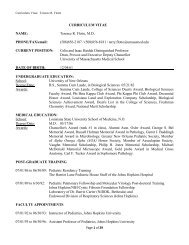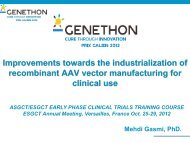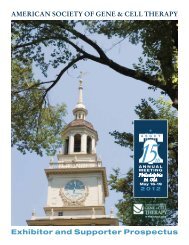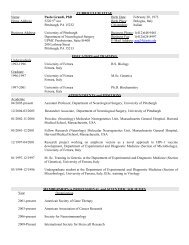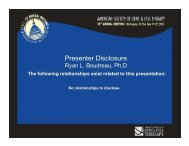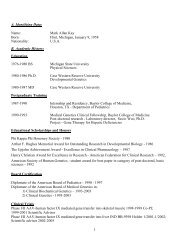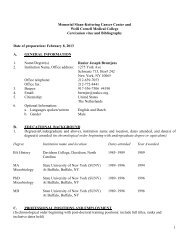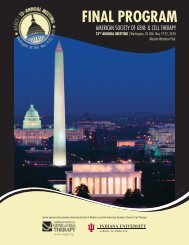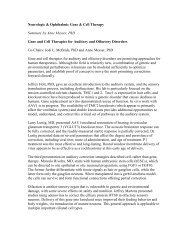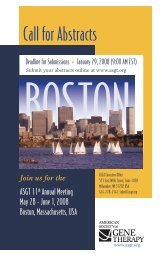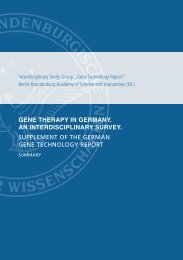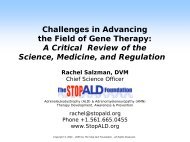Final Program - American Society of Gene & Cell Therapy
Final Program - American Society of Gene & Cell Therapy
Final Program - American Society of Gene & Cell Therapy
You also want an ePaper? Increase the reach of your titles
YUMPU automatically turns print PDFs into web optimized ePapers that Google loves.
<strong>Program</strong> Schedule, Wednesday, May 15, 2013<br />
Wednesday, May 15, 2013<br />
Education Sessions<br />
The goal <strong>of</strong> the ASGCT Education <strong>Program</strong> is to provide participants with a broad background and introduction to topics relevant to the<br />
ield <strong>of</strong> gene and cell therapy. Education Sessions will be subdivided into two headings. “Topical Review” sessions will provide a broad<br />
perspective <strong>of</strong> an area <strong>of</strong> importance to the gene and cell therapy community such as major vector systems, speciic target organs or<br />
diseases, and funding/regulatory issues. “Emerging Field Review” sessions will provide a broad perspective <strong>of</strong> a technological or scientiic<br />
discipline that has recently become <strong>of</strong> great signiicance to ASGCT members.<br />
Education Session 110<br />
10:30 am - 12:00 pm<br />
ROOM: BALLROOM B<br />
Emerging Field Review: <strong>Gene</strong> Targeting<br />
<strong>Gene</strong> targeting, also known as genome editing, has become an increasingly feasible gene therapy strategy. In this education, three pioneers<br />
in the ield will describe different approaches to gene targeting. After this session, attendees should be able to understand the different<br />
approaches to gene targeting and which strategy might be best for their speciic gene therapy application.<br />
CHAIR: Matthew H. Porteus, MD, PhD<br />
SPEAKERS<br />
David W. Russell, MD, PhD<br />
AAV-Mediated <strong>Gene</strong> Targeting<br />
This presentation will describe the mechanism and applications <strong>of</strong> AAV-mediated gene targeting, which has been used to target<br />
over 100 genes in more than 50 different cell types. Sequence changes can be introduced at high frequencies, with up to 1% <strong>of</strong><br />
infected cells undergoing gene targeting. Insertions, deletions and substitutions can all be accurately introduced, and additional<br />
unwanted mutations are not found at targeted loci. Site-speciic nucleases are not required to obtain high targeting frequencies, so<br />
there is no risk <strong>of</strong> introducing DNA breaks at <strong>of</strong>f-target sites.<br />
J. Keith Joung, MD, PhD<br />
Engineered TALENs and CRISPR-Cas RNA-Guided Nucleases (RGNs) for Targeted Genome Editing<br />
Engineered site-speciic nucleases have emerged as a broadly applicable technology for eficiently inducing targeted alterations<br />
in the genomes <strong>of</strong> living cells and organisms. This talk will provide an introduction to two engineered nuclease platforms:<br />
transcription activator-like effector nucleases (TALENs) and CRISPR-Cas RNA-Guided Nucleases (RGNs). The strengths and<br />
limitations <strong>of</strong> each <strong>of</strong> these platforms will be discussed. In addition, publicly available methods and resources for practicing these<br />
technologies will be reviewed.<br />
Dana Carroll, PhD<br />
Nuclease-mediated <strong>Gene</strong> Targeting<br />
With new and rapidly developing technology, it is now possible to make knock-outs and knock-ins in virtually any gene in a wide<br />
range <strong>of</strong> cells and organisms. The secret is the development <strong>of</strong> nucleases that can be designed to cleave arbitrarily chosen genomic<br />
DNA sequences with high speciicity. <strong>Cell</strong>ular repair processes create localized mutations at the nuclease-induced break, or copy<br />
novel sequences from a user-provided template. This talk will cover two classes <strong>of</strong> targetable cleavage reagents, zinc-inger<br />
nucleases (ZFNs) and TALENs. The research and therapeutic potential <strong>of</strong> these reagents is enormous, and ZFNs are currently in<br />
clinical trials.<br />
Education Session 111<br />
10:30 am - 12:00 pm<br />
ROOM: BALLROOM C<br />
Emerging Field Review: Ocular <strong>Gene</strong> <strong>Therapy</strong>: Tools and <strong>Gene</strong>s<br />
Following the success <strong>of</strong> the clinical gene therapy trials for an early onset form <strong>of</strong> inherited blindness called LCA2, the momentum in the<br />
ield <strong>of</strong> ocular gene therapy is palpable. In this session, we try to capture this excitement by providing an in depth review into the genetics<br />
<strong>of</strong> vision and blindness and the technologies that are being developed to therapeutically intervene in the disease course using gene transfer.<br />
This educational session also will discuss disease gene discovery in the genomic era, genetic diagnosis for inherited forms <strong>of</strong> blindness, gene<br />
therapies for blindness under development, and AAV and nanoparticle vector systems for retinal targeting.<br />
36<br />
<strong>Final</strong> <strong>Program</strong> SALT LAKE CITY, UTAH May 15–18, 2013



